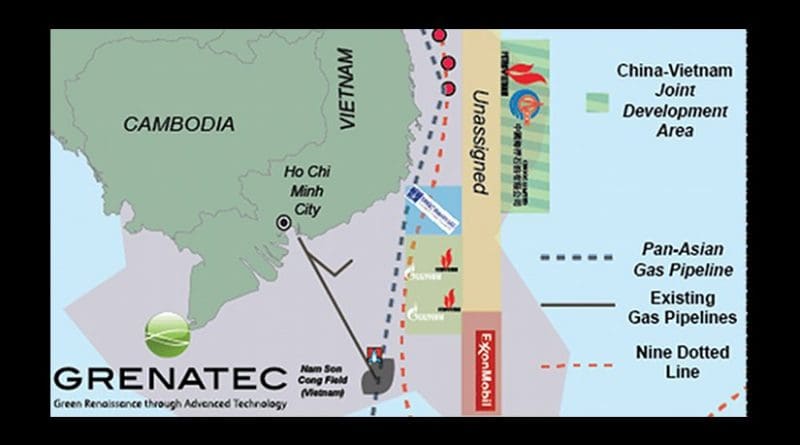South China Sea Joint Development Area: South Vietnam – Analysis
The third most promising location for a South China Sea Joint Development Area (JDA) is off South Vietnam.
The first and second are Triton Island in the Paracels and Reed Bank in the Spratlys.
A South Vietnam offshore JDA would be located in waters surrounding the existing shallow water Nam Son Con oil and gas fields southeast of Ho Chi Minh City.
These would be easy to develop and ideal for interconnection to a Pan-Asian Gas Pipeline (PAGP).
Among the blocks included would be those that China National Overseas Oil Company (CNOOC) attempted to auction in 2012 and 2014. Those auctions failed due to being in waters claimed by Vietnam.
This time, under agreement between Vietnam and China, a smaller section of the disputed blocks could be developed as a JDA linked to the Trans-ASEAN Gas Pipeline project (TAGP).
Multilaterally-utilized, shallow water gas pipelines traversing Vietnam’s near shore waters have been proposed several times over the past 15 years under a series of different names.
In addition, China and Vietnam now cooperate on joint oil and gas exploration In the Tonkin Gulf separating northern Vietnam from China’s southern Hainan Island.
A combined, multilateral JDA/natural gas pipeline construction project involves many parties — corporate and national. It rewards cooperation and compromise.
Offshore Vietnam is the only location in the South China Sea where Indian, Russian (Gazprom), US (Exxon-Mobil) and uninvited Chinese companies (like CNOOC) are all present.
As a small country, Vietnam must juggle the competiting attentions of northern commercial neighbor China, potential military protector America, regional power India and South China Sea wannabe Russia.
For example, Vietnam jointly explores for oil and gas with China in the Tonkin Gulf at the same time as it suffers bullying incursions from Chinese oil and gas exploration rigs in Vietnamese claimed waters further south.
Meanwhile, Russia is building nuclear reactors in Vietnam. India has oil and gas exploration blocks off South Vietnam, and the US is pressing for deeper access to Vietnamese military facilities like Cam Ranh Bay.
Handled adroitly, Vietnam can make a virtue of necessity from all the above. Vietnam’s oil and gas resources are the country’s biggest foreign currency earners. Vietnam’s crude oil reserves are second only to those of China in the immediate region.
In its south, Vietnam has well delineated offshore oil and gas fields and a fledgling pipeline system to bring these resources to shore near Ho Chi Minh city, its southern commercial capital.
Given this, a JDA could be located in unassigned oil and gas exploration blocks to the northeast of the Nam San Con field off Ho Chi Minh city. Some of the proposed JDA blocks would be same as ones CNOOC attempted to auction off in 2014, but got no takers.
Developing these more challenging blocs through a JDA would provide the rationale for building gas pipeline interconnections that could later be interconnected to create a South China Sea-wide network akin to the TAGP.
It would also provide a spur for Vietnam to build an accompanying terrestrial gas pipeline network, which it now lacks. Vietnam currently gets 30% of its power from coal, which needs to change. Gas pipelines can encourage the transition, as well as deepen cross energy market interconnection.
This terrestrial pipeline system could be built alongside — or along rights of way — of the plannned Kunming-Singapore high speed train system. It would also parallel proposed routes for the Trans-ASEAN Electricity Grid, which aims to deepen regional electricity transmission interconnections.
All of the above could be funded by China’s Asian Infrastructure Investment Bank (AIIB) and/or the Asian Development Bank (ADB) alongside precedent-setting AIIB/ADB investments in the Trans-ASEAN Gas Pipeline (TAGP).
Specifically, the TAGP project could connect to, among others, central Vietnam offshore oil and gas blocks now being developed by Petrovietnam and Exxon-Mobil.
That $20 billion project that will include a shallow water pipeline connecting the offshore fields to land south of Da Nang.
That in turn, could spur development of other, secondary fields up and down the coast, lowering costs and increasingly confidence. Ultimately, it would spur movement toward creating a regional market in natural gas. This would increase supply security, competition and lower prices.
A southern Vietnam JDA would join two other JDAs: between Da Nang and Triton Island off northern Vietnam and in the Reed Bank area of the southern Philippines.

